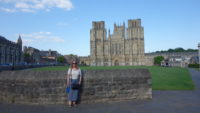 Since Jesus talks about believers becoming “a spring of water welling up to eternal life,” it makes perfect sense that the city of Wells became home to a cathedral, back to at least 900. Wells is home to multiple “wells,” which are areas where an underground river found fissures in rock and so water is forced up to the surface. There is endlessly flowing water right next to the cathedral, which flows in small gutters down the main street of the old part of town.
Since Jesus talks about believers becoming “a spring of water welling up to eternal life,” it makes perfect sense that the city of Wells became home to a cathedral, back to at least 900. Wells is home to multiple “wells,” which are areas where an underground river found fissures in rock and so water is forced up to the surface. There is endlessly flowing water right next to the cathedral, which flows in small gutters down the main street of the old part of town.
It seems that to be classified as a city, the town needs to have a cathedral. Since Wells has one, it is a city, and is the smallest city in England at about twelve thousand people. Our tour of Wells consisted of the cathedral, the Bishop’s Palace next door, and a street next to the church where people have lived continuously since the 1300s. And we took about eleven hours just exploring those three areas. We’re thorough people, and the cathedral has much to see.
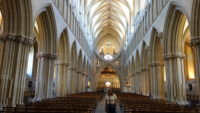 We started with the morning prayer and communion service in the small Lady Chapel at 8:00 am. I think there were about six of us (not counting the dog – England has gone nuts for dogs in a way I hadn’t remembered – they are allowed everywhere now). The service was Church of England, and thus highly liturgical, and that fit the grand surroundings well. It was a pretty service and a nice break from hard-core tourism. We chatted with the priest for about ten minuets afterward, and he kindly pointed out a few things to us and invited us to evensong later in the day.
We started with the morning prayer and communion service in the small Lady Chapel at 8:00 am. I think there were about six of us (not counting the dog – England has gone nuts for dogs in a way I hadn’t remembered – they are allowed everywhere now). The service was Church of England, and thus highly liturgical, and that fit the grand surroundings well. It was a pretty service and a nice break from hard-core tourism. We chatted with the priest for about ten minuets afterward, and he kindly pointed out a few things to us and invited us to evensong later in the day.
 Happily, after the service, we were told the cathedral was open already for visitors, and so we ended up having the entire enormous space completely to ourselves for forty-five minutes (other than running into Basil, a kitty who visits the cathedral every day – very cute and friendly). That was a new experience to us – usually cathedrals are crowded with tourists taking photos and taking tours. Even after one or two people showed up, it was only a few people. We felt like important guests.
Happily, after the service, we were told the cathedral was open already for visitors, and so we ended up having the entire enormous space completely to ourselves for forty-five minutes (other than running into Basil, a kitty who visits the cathedral every day – very cute and friendly). That was a new experience to us – usually cathedrals are crowded with tourists taking photos and taking tours. Even after one or two people showed up, it was only a few people. We felt like important guests.
We did the walking tour out of Mer’s guide book, which took us around the place. My favorite object was the interior clock, which has a clock face dating back to the 1300s. It tells the time and the phase of the moon, and has a little clockwork display at the top where four horsemen joust with each other. The same poor guy gets whacked down every time. Meanwhile, the clock also activates a full-sized “man” sitting next to the clock, and he kicks the bells at his feet every fifteen minutes, and he hits a main bell every hour. Clever stuff from seven hundred years ago.
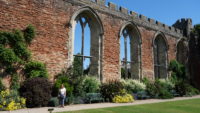 Next door to the church is the Bishop’s Palace, which is where the bishop lived. Over time, the various bishops built a fortified residence, complete with moat. The main dining hall fell into ruin a couple of hundred years ago after the roof started leaking, and a garden has been planted there. One of the main wells springs up on the grounds, and so there are small streams around the property, along with more gardens. Our ticket to the palace is good for a year, so we cut our tour short to go back to the cathedral because Mer had booked us for the “High Places” tour.
Next door to the church is the Bishop’s Palace, which is where the bishop lived. Over time, the various bishops built a fortified residence, complete with moat. The main dining hall fell into ruin a couple of hundred years ago after the roof started leaking, and a garden has been planted there. One of the main wells springs up on the grounds, and so there are small streams around the property, along with more gardens. Our ticket to the palace is good for a year, so we cut our tour short to go back to the cathedral because Mer had booked us for the “High Places” tour.
This is very technical, but in simple terms, the High Places tour takes you upstairs in the cathedral to the high places around the church where people aren’t usually allowed to go. I’m terrible with heights, so it was a bit of a risk, but I love engineering stuff about what holds up big buildings, so that was good. It turned out to be okay – just one terrifyingly high place from which I hung back. The rest was high up, but well protected.
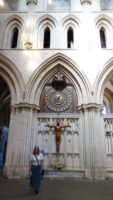 Wells has a lot of water. Cathedrals weigh quite a lot. The original cathedral had a stumpy little main tower. A hundred years later, the bishop decided that this wasn’t good enough, and got people to build a much higher, and heavier, tower. Well and good. Until the stone columns under the tower started to deform – you can see the straight lines of decorative features bend near the tower. The front of the tower sank six inches, and the back sank four. So the cathedral added hidden buttresses to shore up the tower, and added four beautiful scissor arches visible in the main part of the church. These are rare anywhere, and Wells pulled them off superbly. The cathedral is known for the feature now. Our guide said there is some debate as to if they are even needed for the structure anymore, but no one cares. They’re staying put.
Wells has a lot of water. Cathedrals weigh quite a lot. The original cathedral had a stumpy little main tower. A hundred years later, the bishop decided that this wasn’t good enough, and got people to build a much higher, and heavier, tower. Well and good. Until the stone columns under the tower started to deform – you can see the straight lines of decorative features bend near the tower. The front of the tower sank six inches, and the back sank four. So the cathedral added hidden buttresses to shore up the tower, and added four beautiful scissor arches visible in the main part of the church. These are rare anywhere, and Wells pulled them off superbly. The cathedral is known for the feature now. Our guide said there is some debate as to if they are even needed for the structure anymore, but no one cares. They’re staying put.
We clambered around in back spaces and on top of ceilings and such. It was great. We got to see the guts of the clock working, and we saw rough-worked stone that isn’t public-facing. We saw seven-hundred-year-old oak timbers that get stronger as they age (as long as the bugs leave them alone). We got to see a demonstration of choir holes in the front of the church where choir members would sing, making it sound as if the angel statues in front of the church were singing. We got to see the eight trumpet holes at the very top of the façade, where trumpets would be thrust through and played on processional days. I had a ball. Good stuff.
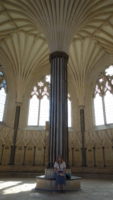 Back on the main floor, we thanked our guide and went to get lunch. We finished with that just in time to catch a free guided tour of the cathedral. For those keeping count, this was our third tour of some kind for the day. The guide shored up some of our newfound knowledge, as well as added a few new bits of information: for instance, no one knows how or why the main thirteenth-century stained glass window survived the Reformation and the English Civil War, when most of the glass in the church was destroyed. We finished the tour in the spectacular Chapter House, which is held up by a central pillar that fans out across the whole ceiling. It is a “wow” moment when you see it.
Back on the main floor, we thanked our guide and went to get lunch. We finished with that just in time to catch a free guided tour of the cathedral. For those keeping count, this was our third tour of some kind for the day. The guide shored up some of our newfound knowledge, as well as added a few new bits of information: for instance, no one knows how or why the main thirteenth-century stained glass window survived the Reformation and the English Civil War, when most of the glass in the church was destroyed. We finished the tour in the spectacular Chapter House, which is held up by a central pillar that fans out across the whole ceiling. It is a “wow” moment when you see it.
We thanked our guide, but we weren’t quite done with church yet. The library is only open from 2:00 to 4:00, so we popped in there to look around. We couldn’t get back to the oldest section, but we could see it, and it still had multiple books with chains attached, which is when books were so valuable they were chained down.
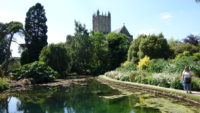 Having finally seen all of the cathedral we could see, we went back to the Bishop’s Palace to finish off the gardens and the house. The house is pretty small, actually – two floors and maybe eight rooms. I think some of the grandeur of the place fell in with the collapse of the great hall.
Having finally seen all of the cathedral we could see, we went back to the Bishop’s Palace to finish off the gardens and the house. The house is pretty small, actually – two floors and maybe eight rooms. I think some of the grandeur of the place fell in with the collapse of the great hall.
We walked around the cathedral to get to Vicars’ Close, the street where the staff of the church used to live. It still is largely used that way, although now it houses families instead of single men. The street is very uniform and is in excellent repair.
Not quite done with the church, we went back in for evensong. The cathedral school attached to the church is one of only three special music schools in England. As the priest told us in the morning, once you see a thirteen-year-old playing Rachmaninoff, it makes you want to give up playing the piano. There is serious talent. Tonight, the evensong was sung by a men’s choir (with one woman), and the harmonies were beautiful. They sang in both English and some old dead language, and it all took place in the choir stalls of the church, so the service felt intimate. It was, as the English are fond of saying, lovely.
 That finally ended our touring day, other than having to go to four restaurants to find one open on a Wednesday. It seems a bit odd to me to have spent nearly eleven hours mostly exploring one building, but as I told Mer, I don’t know what I would have cut out. We got to taste a little bit of the living water today in Wells.
That finally ended our touring day, other than having to go to four restaurants to find one open on a Wednesday. It seems a bit odd to me to have spent nearly eleven hours mostly exploring one building, but as I told Mer, I don’t know what I would have cut out. We got to taste a little bit of the living water today in Wells.
Hmmm. Some old dead language, huh?!?
Basil is adorable!!!
So la tin must be feminine?
It must be. Some typical girly girl teaches it at CVCA,